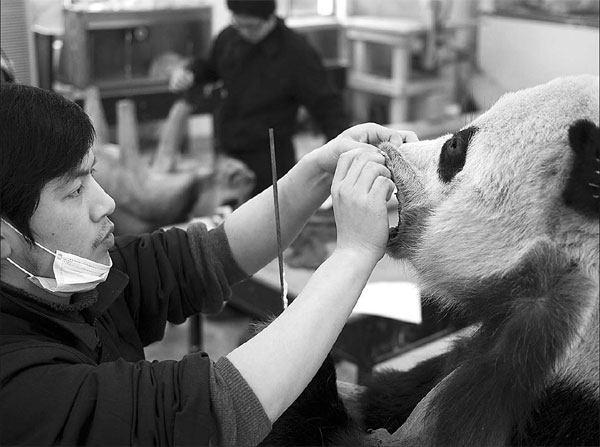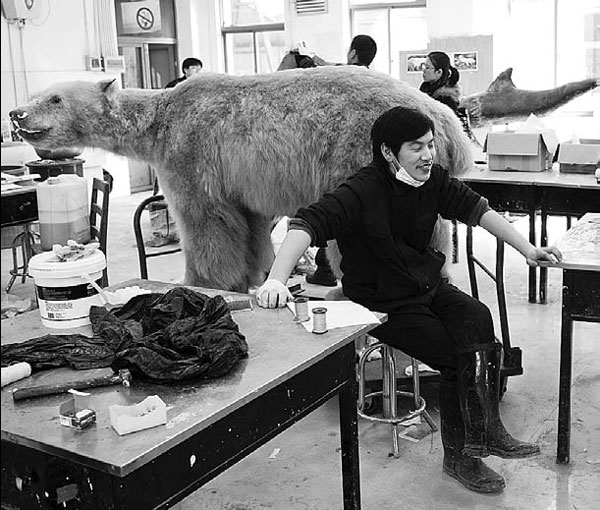The stuffing of legends
Updated: 2013-03-19 05:38
By Wu Ni (China Daily)
|
||||||||
|
Yuan Minjie concentrates on making a panda specimen. Photos by Gao Erqiang / China Daily |
Eight taxidermists painstakingly make animal specimens for the new Shanghai Natural History Museum, scheduled to open early next year. Wu Ni gives the details.
Apeek through a white-colored house on Longwu Road of Shanghai's Xuhui district offers an astonishing scene - a roaring polar bear resting beside a Chinese sturgeon, surrounded by many other rare animals, like giant pandas and crested ibises.
It is not a zoo. It is a workshop where craftsmen make animal specimens for the relocated Shanghai Natural History Museum that is scheduled to open early next year.
As one approaches the workshop, a pungent odor of stale blood, chemicals and decay causes one to frown. But the eight taxidermists, men in their 30s, look oblivious to the stench - each absorbed in their work without wearing a facemask.
"We are used to this, and even bloodier scenes," says Shan Kun, the lead specimen maker.
The center receives dead animals from zoos, wild animal protection zones or donors. The first step is stripping off the fur, then the remains are carefully measured for the size of every muscle. The flesh and guts are removed, while skeletons and fur are preserved in salt and chemical agent.
Taxidermy involves patience and tactics. A 5-meter-tall giraffe specimen, made to look as if it is nibbling leaves on a tree, takes more than six months.
"The skin of the giraffe is thin and crisp - you have to scrape the fat very carefully and the connective tissues that are attached to the skin, because if you scrape too hard, the skin will be damaged," Shan says.
Even the gristle in the giraffe's ears is removed. Tin plates are stuffed so that the ears look real.
"We use quails to practice taxidermy. When I first stripped the little creatures, my hands couldn't help shaking. But now it is easier, after all, we are breathing life into the dead animals," says Shan, who wears a pair of glasses and looks studious. He used to be a narrator at Shanghai Science and Technology Museum.
After taxidermy, the skeleton is constructed to a designated pose with steel, wood and nails. The gestures of animal specimens on display are predefined. Based on the original sizes of each part, clay is pasted on the frame to shape the animals' muscles.
Based on the clay model, plaster is used to make animal mannequins, and finally the preserved fur is sewed onto it. It takes about three months to finish a medium-sized mammal.
In the past, straw and bamboo-made threads were stuffed into the models, which reduced the vividness of specimens.
There are various pictures of different animals on display in the workshop. For each animal, there are a few photos, showing different gestures.
One of the specimen makers, Ma Mingyi, who used to be a sculptor, is especially adept in perfecting the details to make the specimens look lifelike.
"The last phase (of making the specimen) is the most painful, which often involves perfecting the gestures of the specimens, mending the broken parts and adding colors," Ma says, as he meticulously varnishes the nose of the giraffe to make it look wet.
"Have you noticed the noses of pets?" he says. "Wet noses indicate they are healthy."
Ma shares that he once used tweezers to comb the hair of an emperor penguin specimen. "I stared at the penguin and tidied the hair one by one. When I finished the job three days later, everything in my eyes had only two colors: black and white," he recalls.
Artificial eyeballs imported from Germany bring the specimens to life, compared to glass balls, which were widely used before.
"The artificial eyeballs have pupils and are clear and real," Ma says, showing a package of various artificial eyeballs.
Ge Dong, who studied chemistry and joined the team five years ago, says as far as possible they use only environmental friendly materials in the specimen making process.
"The hair of the specimen, in essence, is protein, and attracts worms," Ge says.
He explains that they used to apply arsenic powder on the inside of the fur to keep the worms away, but the chemical is toxic to specimen makers and visitors. "If our hands are cut, the wound is difficult to heal," he says.
But they have recently found arsenic-free chemicals, which also preserve the furs better, Ge says.
The specimen-making center, affiliated to Shanghai Science and Technology Museum, started production in 2007 and has made more than 500 specimens to date.
All the specimens they made will be exhibited in the 45,000 square-meter Shanghai Natural History Museum, which is under construction in Jing'an Sculpture Park.
Part of the 260,000 exhibits in the old museum, which is a 1920s building located in east Yan'an Road of Huangpu district, will be transferred to the new museum, Shan says.
The new museum has also collected more than 10,000 specimens from home and abroad.
Shan is anxious to see his works in the new museum. The father of a 9-month-old baby envisions taking his grandson to the museum one day. "Then I will proudly tell him 'this specimen is made by your grandpa'."
Contact the writer at wuni@chinadaily.com.cn.
|
Craftsmen make animal specimens at a workshop for the relocated Shanghai Natural History Museum that is scheduled to open in early 2014. |
(China Daily 03/19/2013 page20)

 In Photos: 7.0-magnitude quake hits Sichuan
In Photos: 7.0-magnitude quake hits Sichuan
 Li Na on Time cover, makes influential 100 list
Li Na on Time cover, makes influential 100 list
 FBI releases photos of 2 Boston bombings suspects
FBI releases photos of 2 Boston bombings suspects
 World's wackiest hairstyles
World's wackiest hairstyles
 Sandstorms strike Northwest China
Sandstorms strike Northwest China
 Never-seen photos of Madonna on display
Never-seen photos of Madonna on display
 H7N9 outbreak linked to waterfowl migration
H7N9 outbreak linked to waterfowl migration
 Dozens feared dead in Texas plant blast
Dozens feared dead in Texas plant blast
Most Viewed
Editor's Picks

|

|

|

|

|

|
Today's Top News
Live report: 7.0-magnitude quake hits Sichuan, heavy casualties feared
Boston suspect cornered on boat
Cross-talk artist helps to spread the word
'Green' awareness levels drop in Beijing
Palace Museum spruces up
First couple on Time's list of most influential
H7N9 flu transmission studied
Trading channels 'need to broaden'
US Weekly

|

|









